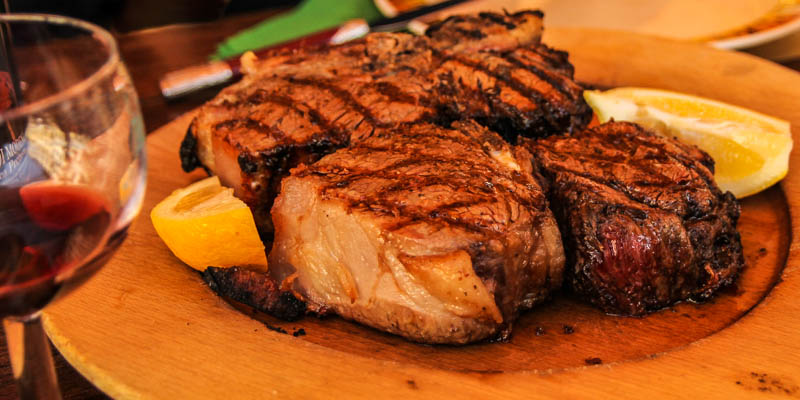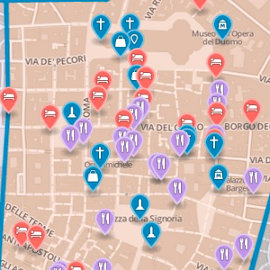Florentine dishes & specialties

A mighty bistecca fiorentina (Florentine steak).
A guide to a meal in Florence, including the most popular dishes and food for which Florence is famous
Great Florentine dining experiences
The typical Florentine meal has many courses, and it can take a few hours to work your way through them properly.
Antipasti (appetizers)
It starts with an antipasto (appetizer), the two most traditionally Tuscan being affettati misti (assorted salami) and crostini misti (rounds of toast topped variously with liver pâté, mushrooms, tomatoes, cheese, etc.).
Primi (first courses)
Your primo (first course) could be a soup. Most popular is the stew-like ribollita , a gloriously delicious peasant dish made with cavolo nero (lacinato kale), cannellini beans, tomatoes, and various other veggies, poured over thick slices of day-old bread then, as the name says, "reboiled" again. Then there's the even simpler pappa al pomodoro (bascially bread and tomatoes with some herbs and spices). Also popular are soups based on farro (a whole grain similar to emmer or barley).
Popular pastas in Florence include spaghetti alla carrettiera (in a spicy tomato sauce) or pasta al pomodoro (in a plain tomato sauce); pappardelle al cinghiale (wide noodles in a wild boar sauce); and crespelle Fiorentine (delicate pasta crepes layered with cheese and béchamel sauce).
Secondi (main courses)
Your secondo (main course) could be a pollo (chicken) dish, scallopine (veal cutlets, cooked in a variety of ways), lombatina di vitello (veal chop), involtini (veal rolled with veggies and stewed in its own juices), or the mighty bistecca fiorentina (a huge steak grilled and brushed with olive oil and pepper).
Contorni (side dishes)
You are expected to order a contorno (side dish) to go with this main dish. They will try to foist spinaci (spinach) off on you, but beware: the Tuscans are partial to boiling spinach 'til it be dead, dead, dead. Far better are the fagioli, which just means "beans" but in Tuscany always always implies white cannellini beans; these are best served all'uccelleto, stewed with sage and tomatoes.
Dolci (desserts)
Finish your meal off with cantucci con vin santo, which are tiny, hard almond cookies (the original biscotti) for dipping in the sweet dessert wine vin santo; or a tiramisù, which is espresso-soaked lady fingers layered with sweetened, creamy mascarpone cheese and dusted with cocoa.
Vini (wines)
The countryside surrounding Florence is world-renowned for its wines—especially the famous red Chianti Classico, which will most likely be the table wine in a Florentine restaurant.
There are other Chianti zones around Florence besides the famous Classico, inclduing Chianti Colli Fiorentini, Chianti Colli Aretini, and Chianti Colli Senesi. My favorite is the Chianti Rufina—which is a wine region, not to be confused with Chianti Ruffino, which are wines from a famous estate and exporter of Chianti Classico.
Also try the more complex and expensive reds from southern Tuscany: Vino Nobile di Montepulciano and Brunello di Montalcino (perfect to go with steak).
Tips & links
Bread and cover
There's an unavoidable charge called pane e coperto ("bread and cover") of about €1 to €5 that's added onto your bill at just about all Florentine restaurants. This is not a scam. This is standard in Italy.
Find out if service tip is included
Don't double-tip by accident. If the menu has a line—usually near the bottom of the front or back—that says "servizio" with either a percentage, an amount, or the word "incluso" after it, that means the tip is automatically included in the price. (If it says "servizio non incluso," tip is, obviously, not included.)
Even if the menu doesn't say it, ask É incluso il servizio? (ay een-CLOU-so eel sair-VEET-zee-yo)—"Is service included?" If not, tip accordingly (10%–15% is standard).
Don't be stingy about tipping, though. If il servizio is, indeed, already included but the service was particularly good, it's customary to round up the bill or leave €1 per person extra—just to show you noticed and that you appreciated the effort.
Tourist menus
The concept of a bargain prix-fixé menu is not popular in Italy. Some restaurants do offer a menu turistico ("tourist menu") which can cost from €8 to €25 and usually entails a choice from among two or three basic first courses (read: different pasta shapes, all in plain tomato sauce), a second course of roast chicken or a veal cutlet, and some water or wine and bread. With very few exceptions, tourist menus tend to live up to their name, appearing only at the sort of tourist-pandering restaurant that the locals wisely steer clear of.
However, a menu a prezzo fisso ("fixed-price menu") is often a pretty good deal, usually offering a bit more choice than a tourist menu for anywher from €10 to €35.
Then—especially at nicer (and pricier) restaurants—there is the menu degustazione ("tasting menu"), usually far more expensive (anywhere from €25 to €110) that is a showcase of the chef's best, or regional specialties, and can make for an excellent way to sample the kitchen's top dishes.
Book ahead
This is the defining factor of Florence tourism: the city gets nearly the same number of visitors as Rome or Venice, yet is a fraction the size. That means lines for everything—and a good incentive to book ahead for meals as frequently as possible. There simply is too much demand for all the good places.
- Order the steak ahead: If you are planning on having a bistecca fiorentina, ask for it when you call for you're reservation. This is only necessary in some place, but it pays to check. (Some joints even insist you order it a day ahead of time.)
Culinary tours of Florence
Cooking classes
Special meals
Vineyard excursions
» Chianti
» Other Tuscan wine regions
General dining tips
- "Pane e coperto" is not a scam: Nearly all Italian restaurants have an unavoidable pane e coperto ("bread and cover" charge) of anything from €1 to €15—though most often €2 to €5—per person that is automatically added onto your bill. This is perfectly normal and perfectly legal (though a few trendy restaurants make a big deal about not charging it).
- Find out if service (tip) is included: Don't double-tip by accident. If the menu has a line—usually near the bottom of the front or back—that says "servizio" with either a percentage, an amount, or the word "incluso" after it, that means the tip is automatically included in the price. (If it says "servizio non incluso," tip is, obviously, not included.)
Even if the menu doesn't say it, ask É incluso il servizio? (ay een-CLOU-so eel sair-VEET-zee-yo)—"Is service included?" If not, tip accordingly (10%–15% is standard).
Don't be stingy about tipping, though. If il servizio is, indeed, already included but the service was particularly good, it's customary to round up the bill or leave €1 per person extra—just to show you noticed and that you appreciated the effort.
- Tourist menus: The concept of a bargain prix-fixe menu is not popular in Italy. Some restaurants do offer a menu turistico ("tourist menu"), which can cost from €8 to €20 and usually entails a choice from among two or three basic first courses (read: different pasta shapes, all in plain tomato sauce), a second course of roast chicken or a veal cutlet, and some water or wine and bread. With very few exceptions, tourist menus tend to live up to their name, appearing only at the sort of tourist-pandering restaurants that the locals wisely steer clear of.
However, a menu à prezzo fisso ("fixed-price menu") is often a pretty good deal, usually offering a bit more choice than a tourist menu.
Then—especially at nicer (and pricier) restaurants—there is the menu degustazione ("tasting menu"), usually far more expensive (anywhere from €25 to €110) that is a showcase of the chef's best, or of regional specialties, and can make for an excellent way to sample the kitchen's top dishes.
- Book ahead: For restaurants that I am truly eager to try, I go ahead and book a table—at least at dinner. I find that a corollary of Murphy's Law seems to apply. If you prudently book ahead, you are likely to show up to a half-empty restaurant and feel a bit like a fool for having worried about finding a table. If, on the other hand, you just show up at the door expecting to find a free table, the place will inevitably be packed and its bookings full for the evening.
Italian dining phrases
| English (Inglese) |
Italian (Italiano) |
Pro-nun-cee-YAY-shun |
| Good day |
Buon giorno |
bwohn JOUR-noh |
| Good evening |
Buona sera |
BWOH-nah SAIR-rah |
| Good night |
Buona notte |
BWOH-nah NOTE-tay |
| Goodbye |
Arrivederci |
ah-ree-vah-DAIR-chee |
| Excuse me (to get attention) |
Scusi |
SKOO-zee |
| thank you |
grazie |
GRAT-tzee-yay |
| please |
per favore |
pair fa-VOHR-ray |
| yes |
si |
see |
| no |
no |
no |
| Do you speak English? |
Parla Inglese? |
PAR-la een-GLAY-zay |
| I don't understand |
Non capisco |
non ka-PEESK-koh |
| I'm sorry |
Mi dispiace |
mee dees-pee-YAT-chay |
| |
|
|
| Where is? |
Dov'é |
doh-VAY |
| ...a restaurant |
un ristorante |
oon rees toh-RAHN-tay |
| ...a casual restaurant |
una trattoria
un'osteria |
oo-nah trah-toar-RHEE-yah
oon ohst-air-EE-yah |
| I would like to reserve... |
Vorrei prenotare... |
voar-RAY pray-note-ARE-eh |
| a table for two |
una tavola per due |
oo-nah TAH-voal-lah pair DOO-way |
| ...for 7pm |
per le sette |
pair lay SET-tay |
| ...for 7:30pm |
per le sette e mezzo |
pair lay SET-tay eh MET-tzoh |
| ...for 8pm |
per le otto |
pair lay OH-toh |
| |
|
|
| I would like |
Vorrei... |
voar-RAY |
| ...some (of) |
un pó (di) |
oon POH (dee) |
| ...this |
questo |
KWAY-sto |
| ...that |
quello |
KWEL-loh |
| chicken |
pollo |
POL-loh |
| steak |
bistecca |
bee-STEAK-ah |
| veal |
vitello |
vee-TEL-oh |
| fish |
pesce |
PEH-shay |
| meat |
carne |
KAR-neh |
| I am vegetarian |
sono vegetariano |
SO-no veg-eh-tair-ee-YAH-no |
| side dish [veggies always come seperately] |
cotorno |
kon-TOR-no |
| dessert |
dolce |
DOAL-chay |
| and |
e |
ay |
| ...a glass of |
un bicchiere di |
oon bee-key-YAIR-eh dee |
| ...a bottle of |
una bottiglia di |
oo-na boh-TEEL-ya dee |
| ...a half-liter of |
mezzo litro di |
MET-tzoh LEE-tro dee |
| ...fizzy water |
acqua gassata |
AH-kwah gah-SAHT-tah |
| ...still water |
acqua non gassata |
AH-kwah noan gah-SAHT-tah |
| ...red wine |
vino rosso |
VEE-noh ROH-so |
| ...white wine |
vino
bianco |
VEE-noh bee-YAHN-koh |
| ...beer |
birra |
BEER-a |
| Check, please |
Il conto, per favore |
eel COAN-toh pair fah-VOAR-eh |
| Is service included? |
É incluso il servizio? |
ay een-CLOU-so eel sair-VEET-zee-yo |
Share this page

Search ReidsItaly.com



